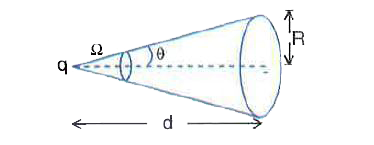A point charge q is placed at distance d from the centre of a circular disc of radiius R. Find electric flux through the disc due to that charge .

We know that total flux original from a point charge q in all directions q∈0 . This flux is originated in a solid angle 4pi . In theh given case solid angle subtended by the cone formed by the disc at the point charge is Ω=2π(1−cosθ)
So, the flux of q which is passing through the surface of the disc is .
ϕ=q∈0Ω4π=q2∈0(1−cosθ)
From the figure , cosθ=d√d2+R2 so ϕ=q2∈0{1−d√d2+R2}
Topper's Solved these Questions
- GAUSS.S LAW BOOK - AAKASH SERIESCHAPTER - GAUSS.S LAW EXERCISE - EXERCISE (LONG ANSWER QUESTIONS)
1 Videos
- GAUSS.S LAW BOOK - AAKASH SERIESCHAPTER - GAUSS.S LAW EXERCISE - EXERCISE (VERY SHORT ANSWER QUESTIONS)
10 Videos
- FRICTION BOOK - AAKASH SERIESCHAPTER - FRICTION EXERCISE - ADDITIONAL PRACTICE EXERCISE PRACTICE SHEET (ADVANCED) (MORE THAN ONE CORRECT ANSWER TYPE QUESTIONS)
1 Videos
- GRAVITATIONBOOK - AAKASH SERIESCHAPTER - GRAVITATIONEXERCISE - ADDITIONAL PRACTICE EXERCISE (LEVEL-II) PRACTICE SHEET (ADVANCED)Integer Type Questions
6 Videos
Similar Questions
A point charge q is placed at a distance d from the centre of a circular disc of radius R. Find electric flux flowing through the disc due to that charge

View SolutionA point charge q is placed at a distance d form the center of circular disc of radius R. Find electric flux through the disc due to that charge

View Solution
Knowledge Check
A point charge q is placed at a distance a/2 directly above the center of a square of side a. The electric flux through the square is
Aqε0Bqπε0Cq4ε0Dq6ε0A position charge Q is placed at a distance of 4R above the centre of a disc of radius R. The magnitude of flux through the disc is ϕ. Now a hemispherical shell of radius R is placed over the disc such that it forms a closed surface. The flux through the curved surface (taking direction of area vector along outward normal as positive), is -
 AzeroBϕC−ϕD2ϕ
AzeroBϕC−ϕD2ϕa point charge q is placed at the centre of a cylinder of length L and radius R the electric flux through the curved surface of the cylinder is
Aqε0L√L2+R2Bqε0L√L2+2R2Cqε0L√L2+4R2Dq2ε0
A point charge q is placed at a distance a/2 directly above the centre of a square of side a. The electric flux through the square is
View SolutionA point charge Q is placed at the centre of circular disc of radius r . Calculate the electric flux associated with circular disc.
View SolutionA position charge Q is placed at a distance of 4R above the centre of a disc of radius R. The magnitude of flux through the disc is ϕ. Now a hemispherical shell of radius R is placed over the disc such that it forms a closed surface. The flux through the curved surface (taking direction of area vector along outward normal as positive), is -

View SolutionA charge q is placed at a distance of 2R from the centre of a spherical conducting shell of radius R. What is electrical potential, due to charges induced on the shell, at a point which is farthest from the point charge ?
View SolutionA charge q is placed at a distance of 2R from the centre of a spherical conducting shell of radius R. What is electrical potential, due to charges induced on the shell, at a point which is farthest from the point charge ?
View Solution
